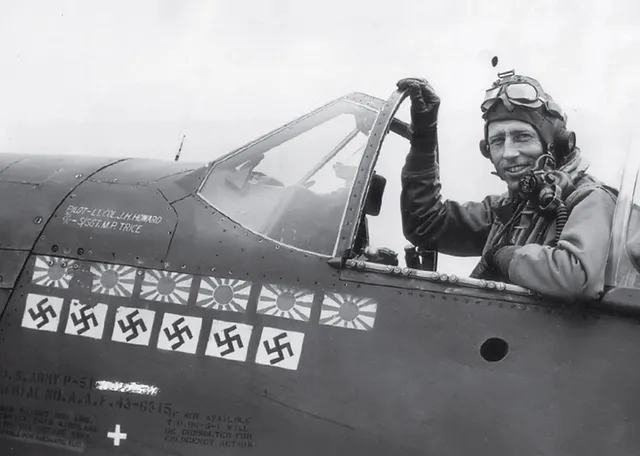
On Jan. 11, 1944 the B-17Gs of the 401st Bomb Group (BG) were bombing Me 110 fighter production plants at Oschersleben and Halberstadt, Germany. It was a rough day for the unit’s bombers: it was their 14th mission, but the first one on which they took heavy losses. Four aircraft in fact went missing in action after having bombed their target.
According to Air Force Magazine, turning for home, they witnessed an amazing sight: a single P-51 stayed with them for an incredible 30 minutes on egress, chasing off German fighters attempting to hack away at the bombers. A “one-man Air Force,” said Maj. Allison C. Brooks, group leader for the 401st’s mission.
“Who was that Mustang pilot who took on the German Air Force single-handedly, and saved our 401st Bomb Group from disaster?” wondered Col. Harold Bowman, the unit’s commander. Soon the B-17 crews knew—and so did those back home. “Maj. James H. Howard was identified today as the lone United States fighter pilot who for more than 30 minutes fought off about 30 German fighters trying to attack Eighth Air Force B-17 formations returning from Oschersleben and Halberstadt in Germany,” reported the New York Times on Jan. 19, 1944.
Future USAF general James Howard began his aviation career as a US Naval Aviator who served with the American Volunteer Group (AVG), where he learned combat leadership and fighter pilot skills. As told by James William “Bill” Marshall and Lowell F. Ford in their book P-51B Mustang North American’s bastard stepchild that saved the Eight Air Force, when the AVG disbanded, Howard joined the USAAF, and he transferred to the 354th Fighter Group (FG) when it was activated.
During the Oschersleben raid on Jan. 11, 1944, he led the 356th Fighter Squadron (FS) in an attack on German fighters swarming around the 401st BG.

Although he soon became separated from his wingman and the rest of his squadron, Howard was confident in the ability of his P-51B (christened ‘Ding Hao!’) to hold its own against an overwhelming number of German fighters (more than 40 were reportedly seen in the area). He engaged the enemy for 30 minutes while flying above the target area, downing three and damaging a fourth to become the 354th FG’s first ace and the first Merlin Mustang fighter ace.
For his efforts Howard became also the only fighter pilot awarded the Medal of Honor in World War II’s European Theater.
The citation read: ‘For conspicuous gallantry and intrepidity above and beyond the call of duty in action with the enemy near Oschersleben, Germany, on 11 January 1944. On that day Col. Howard was the leader of a group of P-51 aircraft providing support for a heavy bomber formation on a long-range mission deep in enemy territory. As Col. Howard’s group met the bombers in the target area the bomber force was attacked by numerous enemy fighters. Col. Howard, with his group, and at once engaged the enemy and himself destroyed a German ME. 110. As a result of this attack Col. Howard lost contact with his group, and at once returned to the level of the bomber formation. He then saw that the bombers were being heavily attacked by enemy airplanes and that no other friendly fighters were at hand. While Col. Howard could have waited to attempt to assemble his group before engaging the enemy, he chose instead to attack single-handed a formation of more than 30 German airplanes. With utter disregard for his own safety he immediately pressed home determined attacks for some 30 minutes, during which time he destroyed 3 enemy airplanes and probably destroyed and damaged others. Toward the end of this engagement 3 of his guns went out of action and his fuel supply was becoming dangerously low. Despite these handicaps and the almost insuperable odds against him, Col. Howard continued his aggressive action in an attempt to protect the bombers from the numerous fighters. His skill, courage, and intrepidity on this occasion set an example of heroism which will be an inspiration to the U.S. Armed Forces.’